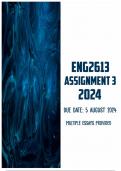, PLEASE USE THIS DOCUMENT AS A GUIDE TO ANSWER YOUR ASSIGNMENT
Please note that the author of this document will not responsibility for any plagiarizing you
commit.
1. Consider the following statement: “Choosing a book for learners is the first step to turning
them into enthusiastic readers.” Drawing on all the knowledge you have gained through this
module, explain how you would go about choosing a text to read with FAL learners in the
Intermediate Phase in a South African, multicultural classroom.
Essay 1
Choosing a book for learners is the first step to turning them into enthusiastic readers. This statement
underscores the profound impact that selecting the right text can have on fostering a love for reading
among learners. In the context of First Additional Language (FAL) learners in the Intermediate
Phase in a South African, multicultural classroom, the task of choosing an appropriate book is even
more complex and nuanced. This essay explores the multifaceted process of selecting a suitable text,
focusing on the essential factors of cultural relevance, age appropriateness, interest in subject matter,
and the balance between diversity and stereotypes. By considering these elements, educators can
ensure that the chosen text not only engages learners but also promotes literacy and critical thinking.
The importance of cultural relevance in book selection cannot be overstated, especially in a South
African classroom characterized by its rich diversity. Cultural relevance refers to the extent to which
a book reflects the cultural backgrounds, experiences, and identities of the learners. When learners
see their own cultures and experiences mirrored in the stories they read, it fosters a sense of identity
and belonging. This can be highly motivating and validating for learners, as it helps them feel seen
and valued. For instance, a story set in a familiar local context with characters that resemble the
learners in terms of language, customs, and social norms can create a more immersive and relatable
reading experience. This approach not only respects the cultural heritage of the learners but also
teaches them to appreciate and understand the diverse cultures within their country.
In a multicultural classroom, selecting a culturally relevant text involves a delicate balance. It is
important to choose books that represent the various cultures present in the classroom while avoiding
those that might alienate or marginalize any group. Educators need to be aware of the cultural
backgrounds of their learners and select texts that are inclusive and representative. This can be
achieved by incorporating books from local authors, stories set in familiar environments, and
narratives that reflect the everyday lives of the learners. Additionally, educators should be mindful of
cultural sensitivities and avoid texts that may perpetuate harmful stereotypes or misrepresent certain
groups.
Age appropriateness is another critical factor in the selection process. The content, language, and
themes of the book must align with the developmental stage of the learners. For Intermediate Phase
learners, typically aged 10 to 12 years, the book should challenge them intellectually while being
accessible. At this stage, learners are developing their reading skills and expanding their vocabulary,
so the chosen text should provide a balance between complexity and comprehensibility. Complex
narratives and abstract themes may be overwhelming, whereas overly simplistic texts might fail to
engage them. Age-appropriate books for this group should strike a balance by offering rich
vocabulary and interesting plots without being too difficult to understand. Ensuring that the text





